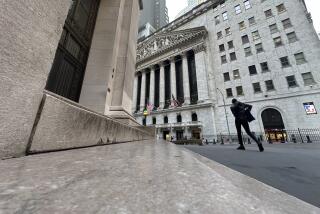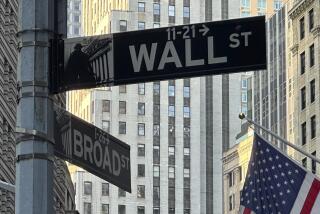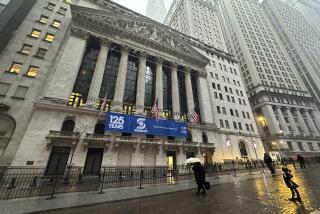Stocks rally amid hope for bailout
NEW YORK — Stock prices stormed upward Tuesday, erasing more than half of Monday’s dramatic plunge, as investors bet that Congress would pass a revamped version of the $700-billion rescue for the sputtering financial system.
In an about-face from the dour mood that pervaded Wall Street a day earlier, financial stocks and other hard-hit sectors regained their balance after the worst sell-off in two almost two decades.
“There was a great deal of shock and disappointment at the defeat of the House bill to resuscitate the financial markets, but subsequent comments suggest that the outlook for passage of the bill is still reasonably good,” said Alan Gayle, senior investment strategist at RidgeWorth Capital Management in Richmond, Va. “That gave the markets a shot in the arm.”
The Dow Jones industrial average, which sank 777 points in its largest-ever point drop Monday, reclaimed 485.21 points, or 4.7%, to close at 10,850.66.
It was the Dow’s third-biggest point gain in history and its best percentage advance since October 2002.
The Standard & Poor’s 500 index surged 58.35 points, or 5.3% to 1,164.74. The Nasdaq composite index climbed 98.60 points, or 5%, to 2,082.33.
But the credit markets remained dysfunctional.
The three-month Libor rate, a measurement of banks’ willingness to lend, rose to 4.05% from 3.88%. Between mid-June and mid-September, the rate held steady at about 2.8%.
“The bottom line is the credit markets are still profoundly broken and they’ll still be that way even if we get a $700-billion package,” said T.J. Marta, a fixed-income strategist at RBC Capital Markets in New York.
Libor levels are important because rates on many business loans and adjustable- rate mortgages are tied to it, meaning that consumers and small-business owners could face much higher borrowing costs unless the Libor rate retreats.
“It is very troubling,” said Art Hogan, chief market strategist at Jefferies & Co. “If you’re trying to borrow money for your business to make payroll and you have to pay 4% for it, it’s very difficult to run a business that way.”
In the stock market, major indexes closed near their highs of the day, an optimistic sign indicating that investors didn’t use the rally as a fleeting opportunity to sell.
Nevertheless, the third quarter, which ended Tuesday, was ugly for shareholders.
The Dow finished the quarter down 4.4% and remains 23.4% off its record high last October.
The S&P; slumped 9% in the quarter, while the Nasdaq fell back 9.2%
The market’s ability to climb further out of its hole may depend on whether a bailout is enacted.
Optimism grew Tuesday that Congress would hammer out a rescue, partly on the theory that Monday’s stock slide left recalcitrant lawmakers so shaken that they now feel compelled to act.
Some legislators reported that calls to their offices from constituents were now in favor of a rescue, a reversal of the sentiment before the vote.
Among the 10 broad industry groups in the S&P; 500, financial stocks topped the leader board Tuesday, climbing 13% after sinking 16% on Monday.
Citigroup and Bank of America jumped 16% on Tuesday, while JPMorgan Chase gained 14%.
Oil prices also reversed course Tuesday. Crude futures rebounded $4.27 to $100.64 a barrel after sliding $10.52 on Monday. As a result, energy stocks, which dropped 11% on Monday, rose 5.8% on Tuesday.
Gold futures, however, slumped $14 to $874.20 an ounce after a $5.30-an-ounce advance Monday.
Large stocks far outpaced smaller issues as investors preferred the relative safety of big companies. The Russell 2,000 small-stock index, which lost 6.7% on Monday, rose 3.3% on Tuesday.
Yields on three-month Treasury bills, which fell sharply Monday, jumped to 0.91% from 0.35% late Monday as some investors shifted out of government securities and into stocks. But the yields remained unusually low, reflecting anxiety about what will happen next in Washington.
Indeed, individual investors appear to be growing fearful of stocks and bonds.
A yearlong exodus out of stock mutual funds picked up steam last month, as investors yanked a net $41 billion on top of the $75 billion they already had withdrawn in the first eight months of the year, according to TrimTabs Investment Research in Santa Rosa. The data are through last Friday.
After pouring a net $95 billion into bond funds this year, nervous investors ran for the exits this month, pulling $22 billion out.
“Individuals have no faith that the government or the leadership or the market leaders are going to get it right, so they’ve been bailing,” TrimTabs Chief Executive Charles Biderman said. “And recently they’ve been bailing ever more.”
--
More to Read
Inside the business of entertainment
The Wide Shot brings you news, analysis and insights on everything from streaming wars to production — and what it all means for the future.
You may occasionally receive promotional content from the Los Angeles Times.










